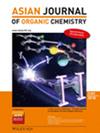Design, Synthesis, Biological Evaluation and Molecular Modeling Studies of Novel Naphthoquinone‐Triazole Hybrids as Potential FGFR1 Tyrosine Kinase Inhibitors
IF 2.8
4区 化学
Q1 CHEMISTRY, ORGANIC
引用次数: 0
Abstract
A new series of 1,4‐naphthoquinone‐triazole derivatives 5–21 were synthesized using nucleophilic substitution and CuAAC reactions. The compounds were investigated for their cytotoxic activities against four cancer cell lines (i. e., HuCCA‐1, T47D, MOLT‐3, and HepG2) as well as a normal cell line (Vero). Most of the compounds showed active cytotoxic effects on all tested cancer cells without cytotoxicity to the normal cells. Particularly, compound 20 showed promising activity against the T47D with comparable effect to that of the known drug, doxorubicin. Compounds 16 and 21 exhibited the greatest FGFR1 inhibitory potency with nanomolar IC50 values of 1.31±0.51 and 3.17±0.33 nM, respectively. Interestingly, the derivative 16 showed comparable inhibitory potency with the known FGFR1 inhibitor, AZD4547. Molecular docking and molecular dynamics simulations were conducted and revealed that both compounds could occupy within the ATP‐binding pocket of the target FGFR1 and shared common interacting key amino acids residues (i. e., Leu484, Val492, and Leu630) with those of inhibitor, AZD4547. The simulations also suggested that the naphthoquinone‐triazole skeleton was found to be a promising structural characteristic essential for effective inhibition of FGFR1. Additionally, the drug‐likeness prediction displayed that these compounds (16 and 21) are drug‐like molecules with possibility for further development.
新型萘醌-三唑复合物作为FGFR1酪氨酸激酶抑制剂的设计、合成、生物学评价和分子模型研究
采用亲核取代和CuAAC反应合成了一系列新的1,4 -萘醌-三唑衍生物5-21。研究了这些化合物对四种癌细胞系的细胞毒活性。, HuCCA‐1,T47D, MOLT‐3和HepG2)以及正常细胞系(Vero)。大多数化合物对所有被试的癌细胞都有活性的细胞毒作用,而对正常细胞没有细胞毒作用。特别是,化合物20对T47D具有与已知药物阿霉素相当的活性。化合物16和21表现出最大的FGFR1抑制效力,其纳米摩尔IC50值分别为1.31±0.51和3.17±0.33 nM。有趣的是,该衍生物16显示出与已知的FGFR1抑制剂AZD4547相当的抑制效力。进行了分子对接和分子动力学模拟,发现这两种化合物都可以占据目标FGFR1的ATP结合口袋内,并且具有共同的相互作用关键氨基酸残基(即。(1)、Leu484、Val492、Leu630)与抑制剂AZD4547的结合。模拟还表明,萘醌-三唑骨架被发现是有效抑制FGFR1所必需的有前途的结构特征。此外,药物相似性预测表明,这些化合物(16和21)是具有进一步开发可能性的药物样分子。
本文章由计算机程序翻译,如有差异,请以英文原文为准。
求助全文
约1分钟内获得全文
求助全文
来源期刊

Asian Journal of Organic Chemistry
CHEMISTRY, ORGANIC-
CiteScore
4.70
自引率
3.70%
发文量
372
期刊介绍:
Organic chemistry is the fundamental science that stands at the heart of chemistry, biology, and materials science. Research in these areas is vigorous and truly international, with three major regions making almost equal contributions: America, Europe and Asia. Asia now has its own top international organic chemistry journal—the Asian Journal of Organic Chemistry (AsianJOC)
The AsianJOC is designed to be a top-ranked international research journal and publishes primary research as well as critical secondary information from authors across the world. The journal covers organic chemistry in its entirety. Authors and readers come from academia, the chemical industry, and government laboratories.
 求助内容:
求助内容: 应助结果提醒方式:
应助结果提醒方式:


